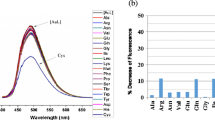Abstract
Here, we are describing the study of the chemiluminescence arising from the reaction of bis (2,4,6-trichlorophenyl) oxalate (TCPO) system with new bis [N-(4-pyridyl)-p-toluene sulfonamide] palladium dichloride (BSPC) as a novel luminescent. The optimum concentrations of all reagents such as sodium salicylate (SS) as catalyst, hydrogen peroxide as oxidizing reagent and the relationships between the chemiluminescence intensity and concentrations of TCPO, SS, hydrogen peroxide and BSPC are reported. After optimization the required reagents, the system were used for determination of amino acid lysine, as an effective and selective quencher in the solution functioning in a Stern–Volmer fashion. This resulted in the development of a facile and highly sensitive chemiluminescence detection scheme for the determination of lysine in biological samples. Ultimately, estimating quenching constant K q of 4.29 × 103 M−1 was successfully carried out. Under the optimal conditions, the evaluated lower and upper detection limits of measurable concentration of lysine are 1.17 × 10−7 and 3.18 × 10−4 M, respectively.









Similar content being viewed by others
References
Kricka LJ (2003) Clinical applications of chemiluminescence. Anal Chim Acta 500:279–286
Liu M, Lin Z, Lin JM (2010) A review on applications of chemiluminescence detection in food analysis. Anal Chim Acta 670:1–10
Gracia LG, Campaña AMG, Pérez JFH, Lara FJ (2009) Chemiluminescence detection in liquid chromatography: Applications to clinical, pharmaceutical, environmental and food analysis-A review. Anal Chim Acta 640:7–28
Campaña AMG, Lara FJ, Gracia LG, Pérez JFH (2009) Chemiluminescence detection coupled to capillary electrophoresis. Trends Anal Chem 28:973–986
Costin JW, Francis PS, Lewis SW (2003) Selective determination of amino acids using flow injection analysis coupled with chemiluminescence detection. Anal Chim Acta 480:67–77
Yari A, Saidikhah M (2010) Chemiluminescence of curcumin and quenching effect of dimethyl sulfoxide on its peroxyoxalate system. J Lumin 130:709–713
Tsunoda M, Imai K (2005) Analytical applications of peroxyoxalate chemiluminescence. Anal Chim Acta 541:13–23
Dodeigne C, Thunus L, Lejeune R (2000) Chemiluminescence as diagnostic tool. A review. Talanta 51:415–439
Yan X (1999) Detection by ozone-induced chemiluminescence in chromatography, review. J Chromatogr A 842:267–308
Kwakman PJM, de Jong GJ, Brinkman UAT (1992) Mechanism of the peroxyoxalate chemiluminescence reaction. Trend Anal Chem 11:232–237
Schuster GB (1979) Chemiluminescence of organic peroxides. Conversion of ground-state reactants to excited-state products by the chemically initiated electron-exchange luminescence mechanism. Acc Chem Res 12:366–373
Qiao M, Guo X, Li FJ (2002) Chemiluminescence detection coupled to high-performance frontal analysis for the determination of unbound concentrations of drugs in protein binding equilibrium. Chromatogr A 952:131–138
Alarfaj NA, Abd ER, Sawsan A (2006) Flow-injection chemiluminescent determination of cefprozil using Tris (2,2’-bipyridyl) ruthenium (II)-permanganate system. J Pharm Biomed Analysis 41:1423–1427
Levesque CL, Moehn S, Pencharz PB, Ball RO (2010) Review of advances in metabolic bioavailability of amino acids. Livestock Sci 133:4–9
Le Floc’h N, Melchior D, Obled C (2004) Modifications of protein and amino acid metabolism during inflammation and immune system activation. Livestock Produc Sci 8737–45
Azevedo RA, Arruda P, Turner WL, Lea PJ (1997) The biosynthesis and metabolism of the aspartate derived amino acids in higher plants. Phytochem 46:395–419
Shamsipur M, Chaichi MJ (2005) A study of quenching effect of sulfur-containing amino acids l-cysteine and l-methionine on peroxyoxalate chemiluminescence of 7-amino-4-trifluoromethylcumarin. J Spectrochim Acta A 61:1227–1231
Mohan AG, Turro NJ (1974) A facile and effective chemiluminescence demonstration experiment. J Chem Educ 51:528–529
Ganbari Kh, Mehdipour E (2005) Synthesis of complexes and its application as catalyst in Heck reaction, MSc. Thesis in Lorestan University
Tonkin SA, Bos R, Dyson GA, Lim KF, Russell RA, Hindson SPCM, Barnett NW (2008) Studies on the mechanism of the peroxyoxalate chemiluminescence reaction Part 2. Further identification of intermediates using 2D EXSY 13C nuclear magnetic resonance spectroscopy. Anal Chim Acta 614:173–181
Orlovic M, Schowen RL, Givens RS, Alvarez F, Matuszewski B, Parekh N (1989) A simplified model for the dynamics of chemiluminescence in the oxalate-hydrogen peroxide system: Toward a reaction mechanism. J Org Chem 54:3606–3610
Hadd AG, Robinson AL, Rowlen KL, Birks JW (1998) Stopped-Flow kinetics investigation of the imidazole-catalyzed peroxyoxalate chemiluminescence reaction. J Org Chem 63:3023–3031
Bos R, Barnett NW, Dyson GA, Lim KF, Russel RA, Watson SP (2004) Studies on the mechanism of the peroxyoxalate chemiluminescence reaction Part 1. Confirmation of 1,2-dioxetanedione as an intermediate using 13C nuclear magnetic resonance spectroscopy. Spectrochim Acta 502:141–147
Robards K, Worsfold PJ (1992) Analytical application of liquid-phase chemiluminescence. Anal Chim Acta 266:147–173
Shamsipur M, Zargoosh K, Hosseini SM, Caltagirone C, Lippolis V (2009) Quenching effect of some heavy metal ions on the fast peroxyoxalate-chemiluminescence of 1-(dansylamidopropyl)-1-aza-4,7,10-trithiacyclododecane as a novel fluorophore. Spectrochim Acta A 74:205–209
Laidler KJ, King MC (1983) The development of Transition-State Theory. J Phys Chem 87:2657–2664
Winzor DJ, Jackson CM (2006) Interpretation of the temperature dependence of equilibrium and rate constants. J Mol Recognit 193:89–407
Dye JL, Nicely VA (1971) A general purpose curve-fitting program for class and research use. J Chem Educ 48:443–450
Bobreshova OV, Agupova MV, Parshina AV (2009) Potentiometric determination of lysine in aqueous solutions using MF-4SK modified perfluorinated membranes. J Anal Chem 64:642–647
Pravin B, Madhavan P, Rao BM, Someswar NR (2010) Determination of arginine, lysine and histidine in drug substance and drug product without derivatisation by using HILIC column LC technique. J Chem Pharm Res 5:580–586
Green NJB, Pimblott SM, Tachiya M (1993) Generalizations of the Stern–Volmer relation. J Phys Chem 97:196–202
Ciscato LFML, Bartoloni FH, Bastos EL, Baader WJ (2009) Direct kinetic observation of the chemiexcitation step in peroxyoxalate chemiluminescence. J Org Chem 74:8974–8979
Author information
Authors and Affiliations
Corresponding author
Rights and permissions
About this article
Cite this article
Yari, A., Mehdipour, E. & Karami, M. New bis[N-(4-pyridyl)-P-Toluene Sulfonamide] Palladium Dichloride a Novel Fluorophore for Determination of Lysine Amino Acid. J Fluoresc 24, 1415–1422 (2014). https://doi.org/10.1007/s10895-014-1423-y
Received:
Accepted:
Published:
Issue Date:
DOI: https://doi.org/10.1007/s10895-014-1423-y




